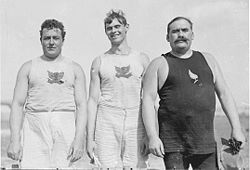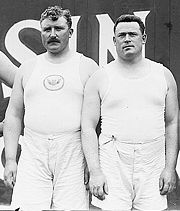
Irish Whales
Encyclopedia

Irish people
The Irish people are an ethnic group who originate in Ireland, an island in northwestern Europe. Ireland has been populated for around 9,000 years , with the Irish people's earliest ancestors recorded having legends of being descended from groups such as the Nemedians, Fomorians, Fir Bolg, Tuatha...
and Irish-American athletes who dominated weight-throwing events in the first two decades of the 20th Century. "This group dominated the field events, particularly throwing events, at the Amateur Athletic Union
Amateur Athletic Union
The Amateur Athletic Union is one of the largest non-profit volunteer sports organizations in the United States. A multi-sport organization, the AAU is dedicated exclusively to the promotion and development of amateur sports and physical fitness programs.-History:The AAU was founded in 1888 to...
national championships and at the Olympic Games
Olympic Games
The Olympic Games is a major international event featuring summer and winter sports, in which thousands of athletes participate in a variety of competitions. The Olympic Games have come to be regarded as the world’s foremost sports competition where more than 200 nations participate...
between 1896 and 1924." They were primarily members of the Irish American Athletic Club
Irish American Athletic Club
The Irish American Athletic Club was an amateur athletic organization, based in Queens, New York at the beginning of the 20th Century.-Early years:...
, and the New York Athletic Club and also members of the New York City Police Department
New York City Police Department
The New York City Police Department , established in 1845, is currently the largest municipal police force in the United States, with primary responsibilities in law enforcement and investigation within the five boroughs of New York City...
. They were known as such because of their athletic prowess, physical size, voracious appetites, and their impact on a generation of sports fans.
The Irish Whales included; John Flanagan, Simon Gillis
Simon Gillis
Simon Gillis was an American track and field athlete, a member of the New York Athletic Club, and the New York City Police Department. He was one of a group of athletes known as the Irish Whales and frequently kept company with members of the Irish American Athletic Club...
, James Mitchell
James Mitchell (athlete)
James Sarsfield "Jim" Mitchel was born in Tipperary, Ireland, and, as an athlete, represented the United States at the 1904 Summer Olympics. Mitchell competed as a member of the New York Athletic Club at the games, which were held in St Louis, Missouri. In the 56 lb weight throw he won the...
, Pat McDonald, Paddy Ryan
Patrick Ryan (athlete)
Patrick James Ryan was an Irish hammer thrower who won the Gold medal as a member of the U.S. Olympic team at the 1920 Summer Olympics in Antwerp, Belgium, winning the event by the biggest winning margin in history...
, Martin Sheridan
Martin Sheridan
Martin John Sheridan was "one of the greatest athletes [the United States] has ever known" according to his obituary in the New York Times. He was born in Bohola, County Mayo, Ireland and died in St. Vincent's Hospital in Manhattan, New York, the day before his 37th birthday, a very early casualty...
, Matt McGrath
Matt McGrath
Matthew John “Matt” McGrath was a member of the Irish American Athletic Club, the New York Athletic Club, and the New York City Police Department. At the time of his death at age 65, he attained the rank of Inspector, and during his career received the NYPD's Medal of Valor twice. He competed for...
and Con Walsh
Con Walsh
Con Walsh was an Irish Canadian athlete who represented Canada at the 1908 Summer Olympics. He won a bronze medal in the hammer throw, finishing third behind fellow Irishmen John Flanagan and Matt McGrath, both of whom represented the United States...
. What Sheridan lacked in girth, he made up for with his appetite and athletic accomplishments, nine Olympic medals in all. "Matt McGrath was built like a wedge. He was a six-footer, but he weighed 248 pounds. John Flanagan was about the same. Simon Gillis was 6'2" and 240. Paddy Ryan was 6'5" and 296, while Pat McDonald was 6'5" and 300 pounds."
Origin

"It was on the Olympic trip of 1912 that the 'whale' nickname took hold. Dan Ferris, then a cherubic little boy, recalls it with relish. 'Those big fellows,' he related, 'all sat at the same table and their waiter was a small chap. Before we reached Stockholm he had lost twenty pounds, worn down by bringing them food. Once as he passed me he muttered under his breath, 'It's whales they are, not men.' They used to take five plates of soup as a starter and then gulp down three or four steaks with trimmings. That Simon Gillis would think nothing of having a dozen eggs for breakfast. But what fascinated me was the way he ate them. He'd put a dab of mustard on each and eat it whole, shell and all.' The Irish American A.C. behemoths always were the life of any party."
Another tale of the Irish Whales voracious appetites came from Arthur Daly's typewriter twenty-two years later. In a Times column in 1964 he wrote:
"Some of their more prodigious feats were at the table. The Irish American A.C. was competing in Baltimore when (Simon) Gillis placed an order for a post-meet snack with the head waiter at a local restaurant. He ordered 27 oysters and six huge T-bone steaks. Slight Miscalculation - The waiter was ready when Gillis, McDonald]] and McGrath arrived. The table had been set for a party of 33. 'Do you want to wait for the rest of your group?' asked the headwaiter. He turned pale as he watched three whales devour 27 oysters and six huge T-bone steaks."

